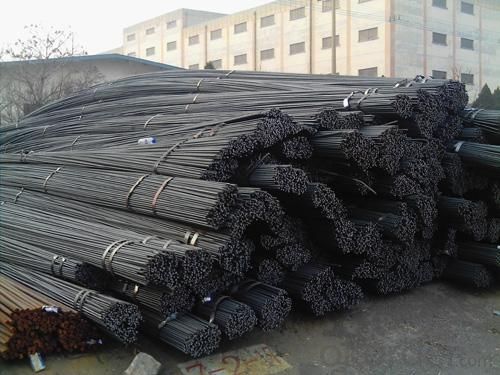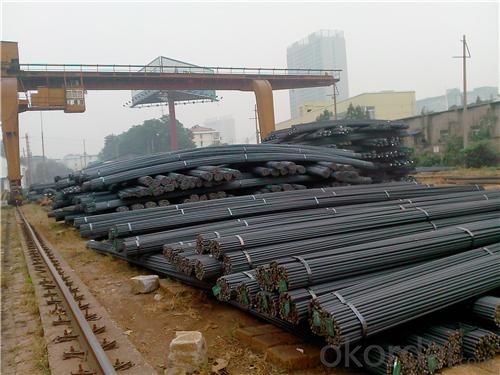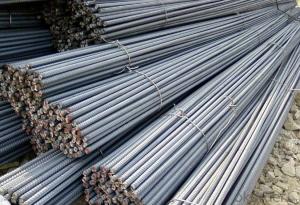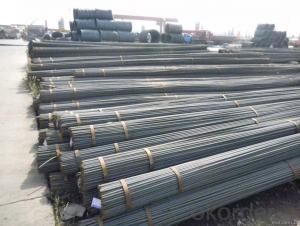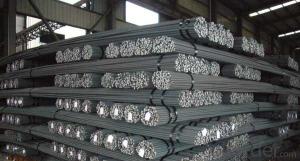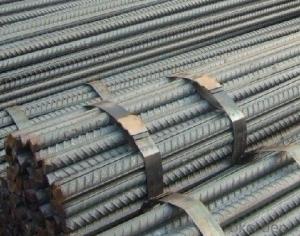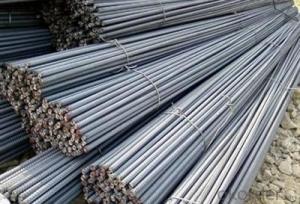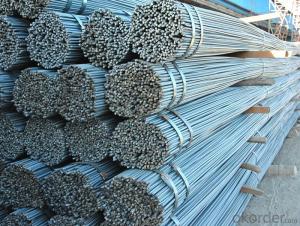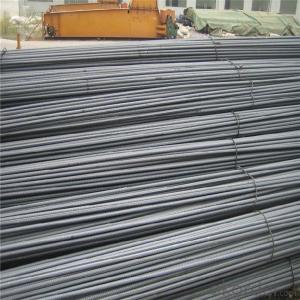55QHG deformed steel bar for construction
- Loading Port:
- Tianjin
- Payment Terms:
- TT OR LC
- Min Order Qty:
- 10000 m.t.
- Supply Capability:
- 100000 m.t./month
OKorder Service Pledge
OKorder Financial Service
You Might Also Like
Specification
OKorder is offering high quality 55QHG deformed steel bar for construction at great prices with worldwide shipping. Our supplier is a world-class manufacturer of steel, with our products utilized the world over. OKorder annually supplies products to European, North American and Asian markets. We provide quotations within 24 hours of receiving an inquiry and guarantee competitive prices.
Product Applications:
55QHG deformed steel bar for construction are ideal for structural applications and are widely used in the construction of buildings and bridges, and the manufacturing, petrochemical, and transportation industries.
Product Advantages:
OKorder's deformed steel bar are durable, strong, and resist corrosion.
Main Product Features:
· Premium quality
· Prompt delivery & seaworthy packing (30 days after receiving deposit)
· Corrosion resistance
· Can be recycled and reused
· Mill test certification
· Professional Service
· Competitive pricing
Product Specifications:
Standard | GB | HRB400 | |
Diameter | 6mm,8mm,10mm,12mm,14mm,16mm,18mm,20mm, 22mm,25mm,28mm,32mm,36mm,40mm,50mm | ||
Length | 6M, 9M,12M or as required | ||
Place of origin | Hebei, China mainland | ||
Advantages | exact size, regular package, chemical and mechanical properties are stable. | ||
Type | Hot rolled deformed steel bar | ||
Brand name | DRAGON | ||
Chemical Composition: (Please kindly find our chemistry of our material based on HRB500 as below for your information)
Grade | Technical data of the original chemical composition (%) | ||||||
C | Mn | Si | S | P | V | ||
HRB400 | ≤0.25 | ≤1.60 | ≤0.80 | ≤0.045 | ≤0.045 | 0.04-0.12 | |
Physical capability | |||||||
Yield Strength (N/cm²) | Tensile Strength (N/cm²) | Elongation (%) | |||||
≥400 | ≥570 | ≥14 | |||||
Theoretical weight and section area of each diameter as below for your information:
Diameter(mm) | Section area (mm²) | Mass(kg/m) | Weight of 12m bar(kg) |
6 | 28.27 | 0.222 | 2.664 |
8 | 50.27 | 0.395 | 4.74 |
10 | 78.54 | 0.617 | 7.404 |
12 | 113.1 | 0.888 | 10.656 |
14 | 153.9 | 1.21 | 14.52 |
16 | 201.1 | 1.58 | 18.96 |
18 | 254.5 | 2.00 | 24 |
20 | 314.2 | 2.47 | 29.64 |
22 | 380.1 | 2.98 | 35.76 |
25 | 490.9 | 3.85 | 46.2 |
28 | 615.8 | 4.83 | 57.96 |
32 | 804.2 | 6.31 | 75.72 |
36 | 1018 | 7.99 | 98.88 |
40 | 1257 | 9.87 | 118.44 |
50 | 1964 | 15.42 | 185.04 |
1.Diameter:6mm-32mm
2.Material:BS4449 Grade 460B,ASTM A615 GR60
3.Length:6-12meters
1. Length: 6m-12m as standard.
2. Reputation first, best competitive price, high quality, quotes price promptly and confirm the delivery on time!
3. Application : Used for housing construction.
4. PRICE: Keep lower operating costs so as to offer competitive price for our clients.
5. Minimum Order Quantity: 300 MTS as per size.
6. Invoicing: Actual or Theoretical Weight Basis as buyer’s request.
7. Payment terms: TT payment in advance or irrevocable LC at sight.
8. Delivery time: 25-30 days after we receive your TT payment at sight
FAQ:
Q1: Why buy Materials & Equipment from OKorder.com?
A1: All products offered byOKorder.com are carefully selected from China's most reliable manufacturing enterprises. Through its ISO certifications, OKorder.com adheres to the highest standards and a commitment to supply chain safety and customer satisfaction.
Q2: How do we guarantee the quality of our products?
A2: We have established an advanced quality management system which conducts strict quality tests at every step, from raw materials to the final product. At the same time, we provide extensive follow-up service assurances as required.

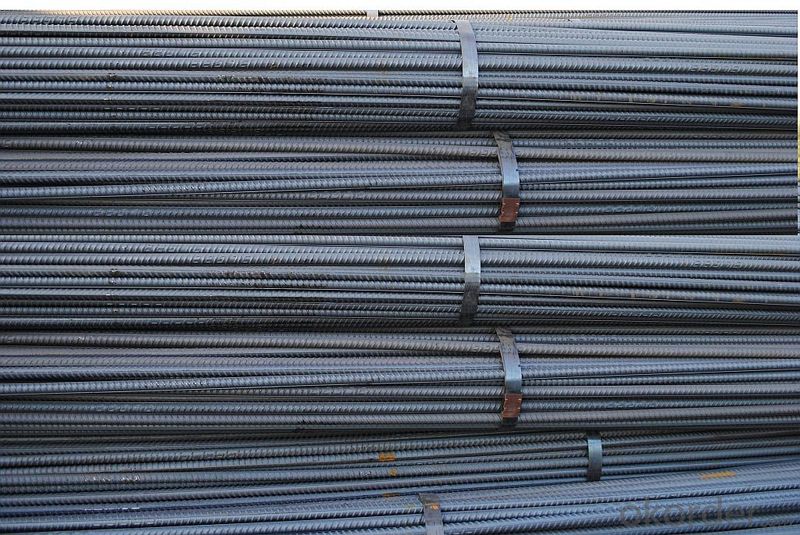
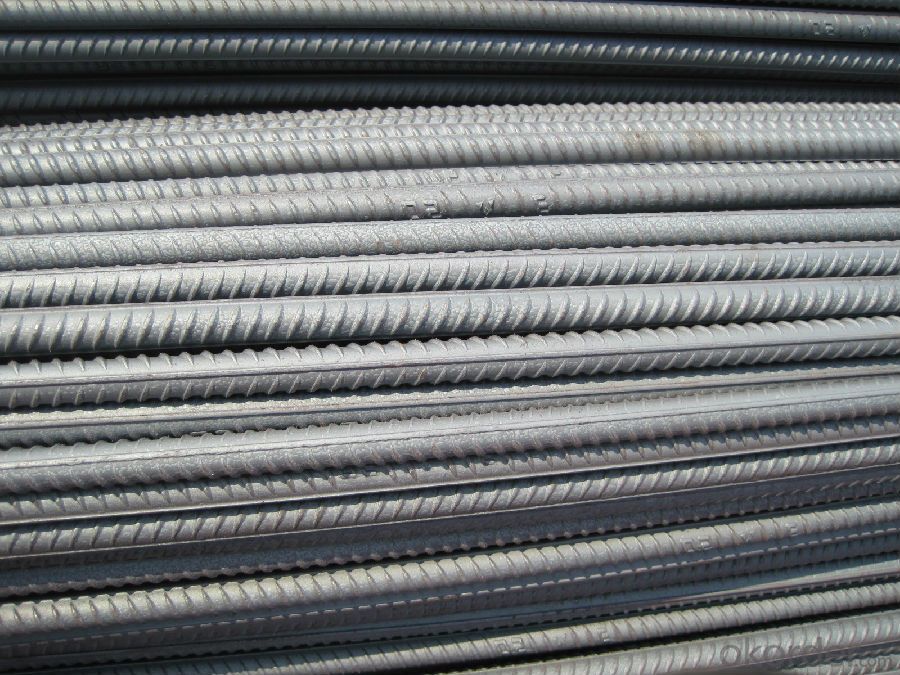
- Q: What is the difference between the II and III grades of threaded steel?
- Third grade rebar than ordinary II rebar strength increased about 20%, is designed for building construction of reinforced structure is developed, the yield strength of 400Mpa (grade HRB400), is the country to promote the use of excellent products.
- Q: What is the maximum tensile force of 25 thread steel?
- The specific parameters of common thread steel are:HRB335: yield strength: 335Mpa, tensile strength 445Mpa, elongation: 17%HRB400: yield strength: 400Mpa, tensile strength 540Mpa, elongation: 16%HRB500: yield strength: 500Mpa, tensile strength 630Mpa, elongation: 15%Ji'nan permanent thread steel tensile strength testing machine, Ji'nan permanent thread steel tensile test machine,
- Q: Are steel rebars suitable for use in structures with high resistance to chemicals?
- Structures requiring high chemical resistance generally cannot utilize steel rebars. Although steel is a robust and durable material, its vulnerability to corrosion when in contact with certain chemicals makes it unsuitable. Acids, alkalis, and chlorides, for example, can corrode steel rebars, compromising the structural integrity of the building or structure. To guarantee chemical resistance, alternative materials such as stainless steel rebars or fiber-reinforced polymer (FRP) rebars are often employed. Stainless steel rebars possess a higher chromium content, which grants them greater corrosion resistance than regular steel rebars. On the other hand, FRP rebars, being non-metallic, do not corrode, making them a viable choice for structures exposed to harsh chemical environments. The selection of rebars for structures demanding high chemical resistance relies on the specific chemicals involved and the degree of exposure. Consulting with engineers and specialists who can assess the chemical environment is essential to determine the most suitable rebars, ensuring the long-term durability and safety of the structure.
- Q: What are the guidelines for proper placement of steel rebars in concrete structures?
- The guidelines for proper placement of steel rebars in concrete structures include ensuring that rebars are properly positioned and supported within the concrete to provide adequate reinforcement. This involves following the specified spacing, cover, and lap length requirements as outlined in the structural design drawings. Additionally, rebars should be properly tied and secured to maintain their position during the concrete pouring process. Adherence to these guidelines is crucial to ensure the structural integrity and durability of the concrete structure.
- Q: How do steel rebars affect the workability of concrete?
- Steel rebars can have a significant impact on the workability of concrete. Firstly, the presence of steel rebars in concrete helps to increase its strength and structural integrity. The rebars act as reinforcement by absorbing and redistributing tensile forces, preventing the concrete from cracking or collapsing under load. However, the addition of steel rebars also affects the workability of concrete in several ways. Firstly, the presence of rebars reduces the workability or slump of the concrete mix. This means that the concrete becomes less fluid and more difficult to handle, especially during pouring and placement. The rebars create obstacles and hinder the flow of concrete, requiring more effort to properly place and compact the mixture. Furthermore, the presence of steel rebars can lead to issues such as segregation and segregation of concrete. Segregation occurs when the heavier rebars cause the aggregate to settle at the bottom, resulting in an uneven distribution of components in the mixture. This can affect the strength and durability of the concrete. Moreover, the presence of rebars may require additional measures to ensure proper bond between the steel and concrete. Adequate cover depth and proper placement of rebars are crucial to ensure that the rebars are fully embedded in the concrete, providing the necessary reinforcement. Failing to achieve proper bond can compromise the strength and structural integrity of the concrete. In conclusion, steel rebars have both positive and negative effects on the workability of concrete. While they enhance the strength and durability of the concrete, they also reduce its workability and require additional considerations during the mixing and placement process. Proper planning and execution are necessary to ensure that the rebars are incorporated effectively and do not hinder the overall workability and performance of the concrete.
- Q: What are the different methods of connecting steel rebars together?
- The connection of steel rebars can be achieved through various methods, depending on the specific needs of the construction project. Here are some commonly used techniques: 1. Lap Splicing: This method involves overlapping two rebars and securing them together using steel wire or bars. It is a cost-effective approach, although it requires longer rebars. 2. Mechanical Splicing: By using a mechanical coupler such as a sleeve or collar, two rebars can be connected. This method offers a strong and reliable connection and allows for flexibility in rebar positioning. It is faster and more efficient than lap splicing. 3. Welding: Steel rebars can be connected by heating and fusing their ends together using an electric arc. This creates a permanent and robust connection. However, welding demands skilled labor and can be time-consuming and expensive. 4. Threaded Couplers: Similar to mechanical splicing, this method involves threading the ends of rebars and connecting them using a threaded coupler. It provides a reliable connection and is commonly used in larger construction projects. 5. Grout Sleeve Splicing: This technique incorporates a grout-filled sleeve between two rebars to establish a connection. The grout enhances strength and stability, making it suitable for seismic zones or areas requiring high strength and ductility. 6. Reinforcing Bar Couplers (RBC): RBC is a proprietary method that employs a threaded sleeve filled with epoxy resin to connect rebars. It offers high load capacity, ease of installation, and resistance to corrosion. To determine the most appropriate method for connecting steel rebars in a specific construction project, it is crucial to consult structural engineers and adhere to building codes and regulations.
- Q: What are the typical costs associated with using steel rebars in a construction project?
- The typical costs associated with using steel rebars in a construction project can vary depending on factors such as the quantity and size of rebars required, market conditions, and location. However, in general, the costs can include the purchase price of the rebars themselves, transportation and delivery expenses, installation labor costs, and any additional fees or taxes. It is advisable to consult with suppliers and contractors to get accurate cost estimates for a specific construction project.
- Q: Can steel rebars be used in decorative concrete applications?
- Yes, steel rebars can be used in decorative concrete applications. They can be used to add structural support and reinforcement to the concrete while also providing a decorative element. The rebars can be shaped or arranged in various patterns to enhance the visual appeal of the concrete surface.
- Q: Can steel rebars be used in concrete columns?
- Yes, steel rebars can be used in concrete columns. In fact, steel rebars are commonly used as reinforcement in concrete structures, including columns. The primary purpose of using rebars in concrete columns is to enhance their strength and durability. The rebars are embedded within the concrete mixture, providing additional tensile strength to the structure. This helps to prevent cracking and failure of the columns under various loads and forces. The use of steel rebars in concrete columns is a widely accepted practice in the construction industry and is essential in ensuring the structural integrity and longevity of the columns.
- Q: How do steel rebars contribute to the crack control in concrete structures?
- Steel rebars contribute to crack control in concrete structures by providing reinforcement and strength. When concrete dries and hardens, it tends to shrink, which can lead to the formation of cracks. However, the presence of steel rebars helps to distribute the internal stresses caused by shrinkage and other factors, thereby reducing the likelihood and extent of cracking. The rebars act as a reinforcement in the concrete, helping to hold it together and preventing cracks from spreading or forming in the first place. Additionally, rebars can also provide resistance against external forces, such as seismic activity or loads, further enhancing the crack control in concrete structures.
Send your message to us
55QHG deformed steel bar for construction
- Loading Port:
- Tianjin
- Payment Terms:
- TT OR LC
- Min Order Qty:
- 10000 m.t.
- Supply Capability:
- 100000 m.t./month
OKorder Service Pledge
OKorder Financial Service
Similar products
Hot products
Hot Searches
Related keywords



